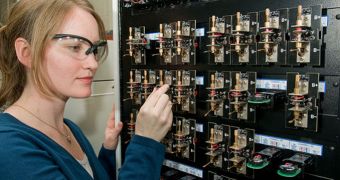According to recent statistics, the United States alone consume more than seven million barrels of gasoline each day, in order for people to power up their cars. Transportation systems around the world are currently being placed under increased strain, and it seems that there is no solution available to replace fossil fuels on the scale required to stop pollution and global warming at this point. Still, experts at the Argonne National Laboratory are currently investigating lithium-air batteries, which they say could solve both problems in one shot, PhysOrg reports.
The ANL team says that its new batteries include an oxygen-supplying air cathode, an electrolyte and a lithium-based anode. The devices may soon become able to store just as much energy as a full tank of gasoline does, but the ANL experts say that capacities five to ten times higher are also possible. The only thing that needs to happen before that becomes possible is the scientific community solving a number of challenges still plaguing this field of research. These issues prevent significant progress in replacing lithium-ion batteries with the new variety at this point.
“The obstacles to Li-air batteries becoming a viable technology are formidable and will require innovations in materials science, chemistry and engineering. We have a history of taking on scientific challenges and overcoming them. Argonne is committed to developing Li-air battery technologies. In fact, we’ve made it a ‘grand research challenge’ at the laboratory,” Eric Isaacs, the director of the US Department of Energy (DOE) lab, says. With its 40-year experience in battery design, the team at Argonne is one of the most capable in the world to complete this task, other scientists say.
“This is not a near-term technology. It is going to take time and collaborations across several scientific disciplines to address the four main challenges of this battery development effort: safety, cost, life and performance,” the ANL Office of Technology Transfer senior account manager Jeff Chamberlain believes. In order to get the job done, researchers at Argonne will have access to some of the most advanced, dedicated facilities in the world: the Advanced Photon Source, the Center for Nanoscale Materials, and the Leadership Computing Facility.

 14 DAY TRIAL //
14 DAY TRIAL //